Latest Posts by carlosalberthreis - Page 2

Após retornar a Parintins, olha quem eu encontrei na Catedral.
Ela mesmo! A Miss Parintins Beatriz Prestes! 👑
Parabéns pela conquista. A cidade está muito bem representada! 🙌🎉
Neste momento começo a assistir a primeira temporada da série @theexpanse.
O que essa série tem a nos mostrar sobre o possível futuro de colonização de outros planetas?!
Vacina Sim

A vacina induz o organismo a criar defesas necessárias para neutralizar o vírus em uma eventual contaminação.
"··· É uma falsa equivalência equiparar o risco da vacina ao COVID. É 100.000 vezes mais perigoso não ser vacinado."
#VacinaSim

Você Nunca Esteve Sozinha
Um jeito diferente de expressar.
Sempre firme com os seus princípios.
Fez o povo se encantar.
Por isso eu concordo e afirmo:
"Fenômenos não se explicam, fenômenos se admiram!"
#VocêNuncaEsteveSozinha #TeamJuliette #JulietteFreire #Globoplay

O povo brasileiro está aguardando se o #BolsonaroVaiCair antes do mês de dezembro desse ano, pois será difícil que ainda seja presidente em 2022.
Nessa semana, aqui em Parintins, costuma ser bastante movimentado.
Porém, devido a pandemia, quando eu fui comprar pão no final da tarde de ontem. Eu percebi que a cidade estava irreconhecível... Sem visitantes, sem sons de toadas, sem alegorias.

As Estrelas do Cruzeiro ✨
A constelação do Cruzeiro do Sul, também conhecida como Crux, é uma das constelações mais conhecidas do hemisfério sul celeste. [...]
O Cruzeiro do Sul tem algumas estrelas que se destacam: A mais brilhante é Acrux (também conhecida como Alfa Crucis ou ainda como Estrela de Magalhães), com magnitude aparente de +0,81; Becrux (também conhecida por Beta Crucis ou ainda por Mimosa); Gacrux (Gama Crucis ou ainda Rubídea); Pálida (ou Delta Crucis) e Intrometida (ou Épsilon Crucis).
Esta constelação tem ainda outros objetos celestes bem interessantes. É o caso da NGC 4755, conhecida como “Caixa de Joias“, sendo este um aglomerado estelar aberto; nesta constelação está também a Nebulosa do Saco de Carvão. [...]
Esta foto foi tirada sob um céu nebuloso, fazendo com que as estrelas se tornassem grandes esferas brilhantes. [...]
📸 Créditos da imagem:
[1] https://upload.wikimedia.org/wikipedia/commons/c/cc/Deep_Crux_wide_field_with_fog.jpg
[2] http://www.iceinspace.com.au/forum/showthread.php?t=89854
📚 Créditos do texto:
[1] https://pt.wikipedia.org/wiki/Crux 2/11
[2] http://www.iau.org/public/constellations/#cru
[3] https://www.siteastronomia.com/cruzeiro-do-sul-constelacao

Em Sintonia com a Natureza
🌿 No VERDE da VIDA. Onde toda a biodiversidade conhecida e catalogada pela ciência dependem de organismos fotossintetizantes, no qual possuem a molécula clorofila, que é responsável em produzir a matéria orgânica que nutre, direta ou indiretamente os seres vivos e garantindo, assim, a manutenção da vida no planeta Terra.
🌎 No AZUL da PROTEÇÃO. Onde a atmosfera é a fina camada gasosa que protege o planeta ao absorver e bloquear a propagação das radiações nocivas para o desenvolvimento da vida, e impede que tenha temperaturas extremas entre o dia e a noite, no qual permite manter a temperatura suficiente para a manutenção da vida.
📸 Créditos da imagem: Maria Gabriela Reis
📅 Data de registro: 12 de Outubro de 2018 às 15:24
📚 Créditos do texto:
[1] Revista Desenvolvida pela Divisão de Atividades Educacionais do Observatório Nacional sobre Atmosfera.
[2] PAULINO, Wilson Roberto: Biologia, Volume 2: Seres Vivos / Fisiologia. 1. ed. São Paulo: Ática, 2005.

Asas da Nuvem
No dia 2 de julho de 2018, logo pela manhã, próximo às 10 horas, quando eu fui observar o movimento no centro da cidade, percebi nesse instante um fato curioso que ocorreu no céu.
Logo de imediato, imaginei as possíveis formas que a nuvem poderia assumir, uma delas sendo um anjo e outra sendo uma borboleta. Após refletir nas possíveis formas, lembrei de um conceito que relaciona esses fatos que ocorrem no cotidiano, que é chamado de PAREIDOLIA.
A pareidolia é um fenômeno neuropsicológico que faz reconhecer um objeto familiar em um estímulo aleatório. [...]
O especialista em neuropsicologia Fabrizio Veloso, profissional associado à Sociedade Brasileira de Psicologia (SBP), afirma que: “Essa tendência de encontrar padrões com significado em imagens ou sons aleatórios está relacionada com a capacidade que o nosso cérebro possui de transformar nossas percepções em algo familiar, ou seja, relaciona-se à forma como construímos o mundo ao nosso redor”.
Assim, estímulos visuais – ou sonoros – aleatórios tendem a ser traduzidos, reconhecidos e associados por nossos cérebros a objetos e estímulos familiares. E nada mais familiar para humanos desde a infância do que outros rostos humanos, daí a frequência da identificação de faces onde elas não existem objetivamente. [...]
Se isso acontece com você, fique tranquilo. É absolutamente normal, garante a ciência.
Data de registro: 2 de julho de 2018 às 09:43
Créditos do texto: Sociedade Brasileira de Psicologia (SBP). Disponível em:

A pandemia do coronavírus (COVID-19) estará marcado na história mundial. Pois, além de ser capaz de paralisar as atividades econômicas no mundo inteiro, esta situação, para diversos economistas, poderá ocasionar uma recessão mundial bastante significativa. #FicaEmCasa

A cidade de Parintins está nos dias de festa religiosa, e então, resolvi relembrar a visita no local mais alto da torre da catedral, onde está localizado a estátua de Nossa Senhora do Carmo. #TorredaCatedraldeParintins Data de registro: 16 de julho de 2018 às 18h18
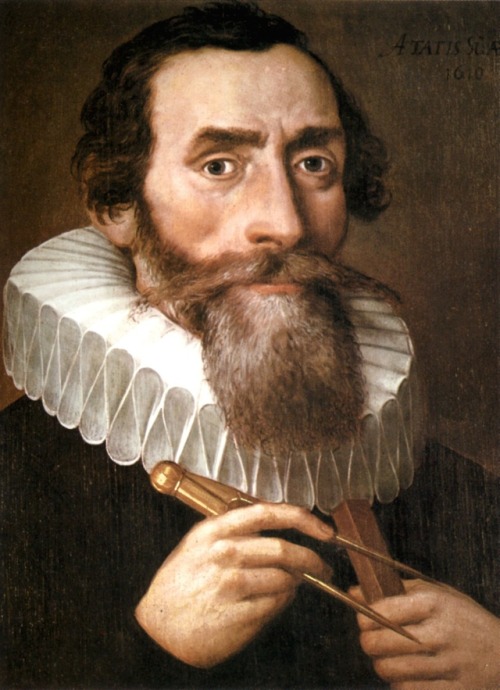
Johannes Kepler
Johannes Kepler was a German mathematician, astronomer, and astrologer.
Kepler is a key figure in the 17th-century scientific revolution. He is best known for his laws of planetary motion, based on his works Astronomia nova, Harmonices Mundi, and Epitome of Copernican Astronomy. These works also provided one of the foundations for Isaac Newton’s theory of universal gravitation.
In astronomy, Kepler’s laws of planetary motion are three scientific laws describing the motion of planets around the Sun.
The orbit of a planet is an ellipse with the Sun at one of the two foci.

A line segment joining a planet and the Sun sweeps out equal areas during equal intervals of time.

The square of the orbital period of a planet is proportional to the cube of the semi-major axis of its orbit.

Most planetary orbits are nearly circular, and careful observation and calculation are required in order to establish that they are not perfectly circular. Calculations of the orbit of Mars, whose published values are somewhat suspect, indicated an elliptical orbit. From this, Johannes Kepler inferred that other bodies in the Solar System, including those farther away from the Sun, also have elliptical orbits.
Kepler’s work (published between 1609 and 1619) improved the heliocentric theory of Nicolaus Copernicus, explaining how the planets’ speeds varied, and using elliptical orbits rather than circular orbits with epicycles.
Isaac Newton showed in 1687 that relationships like Kepler’s would apply in the Solar System to a good approximation, as a consequence of his own laws of motion and law of universal gravitation.
Johannes Kepler
Kepler’s laws of planetary motion
What's That Space Rock?
The path through the solar system is a rocky road. Asteroids, comets, Kuiper Belt Objects—all kinds of small bodies of rock, metal and ice are in constant motion as they orbit the Sun. But what’s the difference between them, anyway? And why do these miniature worlds fascinate space explorers so much? The answer is profound: they may hold the keys to better understanding where we all come from. Here’s 10 things to know about the solar system this week:

This picture of Eros, the first of an asteroid taken from an orbiting spacecraft, came from our NEAR mission in February 2000. Image credit: NASA/JPL
1. Asteroids
Asteroids are rocky, airless worlds that orbit our Sun. They are remnants left over from the formation of our solar system, ranging in size from the length of a car to about as wide as a large city. Asteroids are diverse in composition; some are metallic while others are rich in carbon, giving them a coal-black color. They can be “rubble piles,” loosely held together by their own gravity, or they can be solid rocks.
Most of the asteroids in our solar system reside in a region called the main asteroid belt. This vast, doughnut-shaped ring between the orbits of Mars and Jupiter contains hundreds of thousands of asteroids, maybe millions. But despite what you see in the movies, there is still a great deal of space between each asteroid. With all due respect to C3PO, the odds of flying through the asteroid belt without colliding with one are actually pretty good.
Other asteroids (and comets) follow different orbits, including some that enter Earth’s neighborhood. These are called near-Earth objects, or NEOs. We can actually keep track of the ones we have discovered and predict where they are headed. The Minor Planet Center (MPC) and Jet Propulsion Laboratory’s Center for Near Earth Object Studies (CNEOS) do that very thing. Telescopes around the world and in space are used to spot new asteroids and comets, and the MPC and CNEOS, along with international colleagues, calculate where those asteroids and comets are going and determine whether they might pose any impact threat to Earth.
For scientists, asteroids play the role of time capsules from the early solar system, having been preserved in the vacuum of space for billions of years. What’s more, the main asteroid belt may have been a source of water—and organic compounds critical to life—for the inner planets like Earth.

The nucleus of Comet 67P/Churyumov-Gerasimenko, as seen in January 2015 by the European Space Agency’s Rosetta spacecraft. Image credit: ESA/Rosetta/NAVCAM – CC BY-SA IGO 3.0
2. Comets
Comets also orbit the Sun, but they are more like snowballs than space rocks. Each comet has a center called a nucleus that contains icy chunks of frozen gases, along with bits of rock and dust. When a comet’s orbit brings it close to the Sun, the comet heats up and spews dust and gases, forming a giant, glowing ball called a coma around its nucleus, along with two tails – one made of dust and the other of excited gas (ions). Driven by a constant flow of particles from the Sun called the solar wind, the tails point away from the Sun, sometimes stretching for millions of miles.
While there are likely billions of comets in the solar system, the current confirmed number is 3,535. Like asteroids, comets are leftover material from the formation of our solar system around 4.6 billion years ago, and they preserve secrets from the earliest days of the Sun’s family. Some of Earth’s water and other chemical constituents could have been delivered by comet impacts.

An artist re-creation of a collision in deep space. Image credit: NASA/JPL-Caltech
3. Meteoroids
Meteoroids are fragments and debris in space resulting from collisions among asteroids, comets, moons and planets. They are among the smallest “space rocks.” However, we can actually see them when they streak through our atmosphere in the form of meteors and meteor showers.

This photograph, taken by an astronaut aboard the International Space Station, provides the unusual perspective of looking down on a meteor as it passes through the atmosphere. The image was taken on Aug. 13, 2011, during the Perseid meteor shower that occurs every August. Image credit: NASA
4. Meteors
Meteors are meteoroids that fall through Earth’s atmosphere at extremely high speeds. The pressure and heat they generate as they push through the air causes them to glow and create a streak of light in the sky. Most burn up completely before touching the ground. We often refer to them as “shooting stars.” Meteors may be made mostly of rock, metal or a combination of the two.
Scientists estimate that about 48.5 tons (44,000 kilograms) of meteoritic material falls on Earth each day.

The constellation Orion is framed by two meteors during the Perseid shower on Aug. 12, 2018 in Cedar Breaks National Monument, Utah. Image credit: NASA/Bill Dunford
5. Meteor Showers
Several meteors per hour can usually be seen on any given night. Sometimes the number increases dramatically—these events are termed meteor showers. They occur when Earth passes through trails of particles left by comets. When the particles enter Earth’s atmosphere, they burn up, creating hundreds or even thousands of bright streaks in the sky. We can easily plan when to watch meteor showers because numerous showers happen annually as Earth’s orbit takes it through the same patches of comet debris. This year’s Orionid meteor shower peaks on Oct. 21.

An SUV-sized asteroid, 2008TC#, impacted on Oct. 7, 2008, in the Nubian Desert, Northern Sudan. Dr. Peter Jenniskens, NASA/SETI, joined Muawia Shaddas of the University of Khartoum in leading an expedition on a search for samples. Image credit: NASA/SETI/P. Jenniskens
6. Meteorites
Meteorites are asteroid, comet, moon and planet fragments (meteoroids) that survive the heated journey through Earth’s atmosphere all the way to the ground. Most meteorites found on Earth are pebble to fist size, but some are larger than a building.
Early Earth experienced many large meteorite impacts that caused extensive destruction. Well-documented stories of modern meteorite-caused injury or death are rare. In the first known case of an extraterrestrial object to have injured a human being in the U.S., Ann Hodges of Sylacauga, Alabama, was severely bruised by a 8-pound (3.6-kilogram) stony meteorite that crashed through her roof in November 1954.

The largest object in the asteroid belt is actually a dwarf planet, Ceres. This view comes from our Dawn mission. The color is approximately as it would appear to the eye. Image credit: NASA/JPL-Caltech/UCLA/MPS/DLR/IDA
7. Dwarf Planets
Don’t let the name fool you; despite their small size, dwarf planets are worlds that are just as compelling as their larger siblings. Dwarf planets are defined by astronomers as bodies massive enough to be shaped by gravity into a round or nearly round shape, but they don’t have enough of their own gravitational muscle to clear their path of other objects as they orbit the Sun. In our solar system, dwarf planets are mostly found in the Kuiper Belt beyond Neptune; Pluto is the best-known example. But the largest object in the asteroid belt is the dwarf planet Ceres. Like Pluto, Ceres shows signs of active geology, including ice volcanoes.
8. Kuiper Belt Objects
The Kuiper Belt is a disc-shaped region beyond Neptune that extends from about 30 to 55 astronomical units – that is, 30 to 55 times the distance from the Earth to the Sun. There may be hundreds of thousands of icy bodies and a trillion or more comets in this distant region of our solar system.

An artist’s rendition of the New Horizons spacecraft passing by the Kuiper Belt Object MU69 in January 2019. Image credits: NASA/JHUAPL/SwRI
Besides Pluto, some of the mysterious worlds of the Kuiper Belt include Eris, Sedna, Quaoar, Makemake and Haumea. Like asteroids and comets, Kuiper Belt objects are time capsules, perhaps kept even more pristine in their icy realm.

This chart puts solar system distances in perspective. The scale bar is in astronomical units (AU), with each set distance beyond 1 AU representing 10 times the previous distance. One AU is the distance from the Sun to the Earth, which is about 93 million miles or 150 million kilometers. Neptune, the most distant planet from the Sun, is about 30 AU. Image credit: NASA/JPL-Caltech
9. Oort Cloud Objects
The Oort Cloud is a group of icy bodies beginning roughly 186 billion miles (300 billion kilometers) away from the Sun. While the planets of our solar system orbit in a flat plane, the Oort Cloud is believed to be a giant spherical shell surrounding the Sun, planets and Kuiper Belt Objects. It is like a big, thick bubble around our solar system. The Oort Cloud’s icy bodies can be as large as mountains, and sometimes larger.
This dark, cold expanse is by far the solar system’s largest and most distant region. It extends all the way to about 100,000 AU (100,000 times the distance between Earth and the Sun) – a good portion of the way to the next star system. Comets from the Oort Cloud can have orbital periods of thousands or even millions of years. Consider this: At its current speed of about a million miles a day, our Voyager 1 spacecraft won’t reach the Oort Cloud for more than 300 years. It will then take about 30,000 years for the spacecraft to traverse the Oort Cloud, and exit our solar system entirely.

This animation shows our OSIRIS-REx spacecraft collecting a sample of the asteroid Bennu, which it is expected to do in 2020. Image credit: NASA/Goddard Space Flight Center
10. The Explorers
Fortunately, even though the Oort Cloud is extremely distant, most of the small bodies we’ve been discussing are more within reach. In fact, NASA and other space agencies have a whole flotilla of robotic spacecraft that are exploring these small worlds up close. Our mechanical emissaries act as our eyes and hands in deep space, searching for whatever clues these time capsules hold.
A partial roster of our current or recent missions to small, rocky destinations includes:
OSIRIS-REx – Now approaching the asteroid Bennu, where it will retrieve a sample in 2020 and return it to the Earth for close scrutiny.
New Horizons – Set to fly close to MU69 or “Ultima Thule,” an object a billion miles past Pluto in the Kuiper Belt on Jan. 1, 2019. When it does, MU69 will become the most distant object humans have ever seen up close.
Psyche – Planned for launch in 2022, the spacecraft will explore a metallic asteroid of the same name, which may be the ejected core of a baby planet that was destroyed long ago.
Lucy – Slated to investigate two separate groups of asteroids, called Trojans, that share the orbit of Jupiter – one group orbits ahead of the planet, while the other orbits behind. Lucy is planned to launch in 2021.
Dawn – Finishing up a successful seven-year mission orbiting planet-like worlds Ceres and Vesta in the asteroid belt.
Plus these missions from other space agencies:
The Japan Aerospace Exploration Agency (JAXA)’s Hayabusa2– Just landed a series of small probes on the surface of the asteroid Ryugu.
The European Space Agency (ESA)’s Rosetta – Orbited the comet 67P/Churyumov-Gerasimenko and dispatched a lander to its surface.
Make sure to follow us on Tumblr for your regular dose of space: http://nasa.tumblr.com.
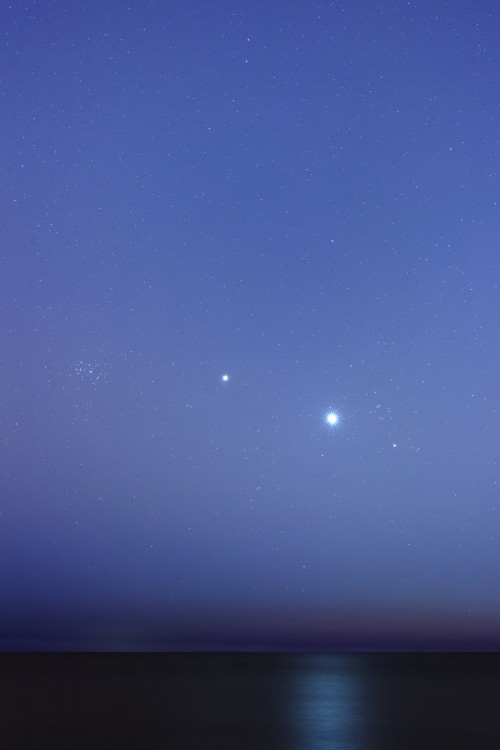
Aldebaran, Venus, Jupiter and Pleiades - Buenos Aires, Argentina.
Image credit: Luis Argerich

Independente de estar classificado ou não, sempre serei #Cruzeiro 🔵✨




Comet C/2016 R2 (now with a biparted tail) passing California Nebula
by Ritzelmut
A China lançou com sucesso um satélite de comunicação lunar, desenvolvido para ajudar na missão histórica que o país lançará ainda em 2018 de colocar um lander e um rover no lado distante (escuro, oculto) da Lua. Além de servir como relay de dados, esse satélite ainda fará experimentos astronômicos.
O satélite de relay da Chang’e-4, está sendo acompanhado por dois microssatélites, e tudo isso foi lançado a bordo de um foguete Long March 4C direto do Xichang Satellite Launch Centre, às 18:28 hora de Brasília, desse domingo, dia 20 de Maio de 2018.
A sonda foi inserida com sucesso na órbita de transferência lunar e se separou do estágio superior de seu foguete. O China Aerospace Science and Technology Corporation, o CASC, o principal contratante para o programa espacial, confirmou o sucesso em menos de uma hora após o lançamento.
Chamado de Queqiao, o satélite está agora numa jornada de 8 a 9 dias até o segundo ponto de Lagrange do sistema Terra-Lua, conhecido como E-M L2, que fica entre 60 e 80 mil quilômetros além da Lua, ou seja, a quase meio milhão de quilômetros da Terra.
O principal objetivo da missão é fornecer um meio de comunicação para as operações de um lander e de um rover lunar que serão colocados no lado distante da Lua, algo que nunca foi testado antes.
Como a Lua é travada gravitacionalmente com a Terra, esse lado distante, nunca está voltado para a Terra. Pousar missões ali, requer um sistema de comunicação com base nesses satélites que fazem o relay dos dados e que sempre estarão com as estações em Terra e com o lander e rover na sua linha de visada.
O ponto E-M L2 que é gravitacionalmente estável irá fornecer essa posição e a órbita adequada para o satélite realizar a sua função.
Queqiao, irá fazer um sobrevoo lunar para ser lançado para seu destino além da Lua e usará seu próprio sistema de propulsão para entrar numa órbita halo ao redor do ponto de Lagrange.
Uma vez no seu ponto, o satélite de 448 kg CAST100, desenvolvido pela China Academy of Space Technology, a CAST, uma empresa fabricante de sondas que trabalha para o CASC, irá testar sua antena parabólica de 4.2 metros de diâmetro e todas as funções antes que a missão levando o lander e o rover chegue na Lua.
O satélite enviado hoje, marca a quinta missão lunar chinesa, contando os dois módulos orbitais, Chang’e-1 em 2007, o Chang’e-2 em 2010, o rover e lander lunar da missão Chang’e-3 de 2013, e uma missão teste de retorno de amostras da Lua em 2014.
Em 2019, a China irá lançar a missão Chang’e-5 para coletar 2 kg de amostras do solo lunar e mandar de volta para Terra.
O lançamento desse domingo, dia 20 de Maio de 2018, marcou o décimo quinto lançamento da China em 2018, lembrando que a China pretende fazer cerca de 40 lançamentos nesse ano, o que dá quase 1 lançamento por semana.
Além de ajudar nas missões que pousarão na Lua, o satélite também irá usar 3 antenas de 5 metros de diâmetro de monopólio que serão usadas para realizar uma astronomia de frequência muito baixa que é impossível de ser feita na Terra, devido à atmosfera do nosso planeta.
A Netherlands-China Low frequency Explorer, ou NCLE, desenvolvido pela Readbound University, e outros, irá tentar detectar um sinal de baixa frequência proveniente da era negra do universo, algo que aconteceu poucas centenas de milhões de anos após o Big Bang, antes das primeiras estrelas brilharem.
Outros objetivos, disse Marc Klein Wolt, da Readbound University, e líder de projeto do NCLE, incluem, pesquisas do Sistema Solar nessas frequências, além de agir como uma base para futuras missões.
Perguntado se o NCLE poderia também, apesar de não ser o objetivo científico da equipe, contribuir para a pesquisa por inteligência extraterrestre, Klein Wolt, disse que, “em princípio poderia, já que nós estamos abrindo uma nova janela para o universo, mas eu não estou esperando encontrar qualquer ET”.
Dois microssatélites, o Longjiang-1 e 2, também estavam a bordo do foguete chinês, e tentarão entrar numa órbita lunar altamente elíptica para realizar suas tarefas astronômicas.
Os satélites pesando 45 kg e com dimensões de 50x50x40 cm, desenvolvidos pelo Harbin Institute of Technology, o HIT, em Heilongjiang , usará antenas de 1 metro para testar radioastronomia de baixa frequência e um tipo de interferometria baseada no espaço.
Principalmente usado como uma verificação técnica para futuras missões, o par de pequenos satélites também está levando experimentos de rádio amadores, além de uma pequena câmera óptica desenvolvida pela Arábia Saudita.
A Chang’e-4 era considerada primeiramente como uma missão reserva da Chang’e-3 que levou o rover Yutu para tocar o solo do Mare Imbrium em 2013.
Como a missão foi realizada com sucesso, apesar de uma falha mecânica no Yutu, a sonda Chang’e-4 foi então confirmada como sendo a missão para o lado distante da Lua.
O alvo para que a Chang’e-4 pouse na Lua é dentro da cratera Von Kármán, que fica na Bacia Aitken do Polo Sul, uma área intrigante do ponto de vista científico, que pode oferecer uma grande ideia sobre a história e sobre o desenvolvimento tanto da Lua como do nosso Sistema Solar.
As câmeras na Chang’e-3 mandaram imagens espetaculares do Mare Imbrium, e o mesmo espera-se da Chang’e-4. A Chang’e-3 fez inúmeras descobertas com seus instrumentos, incluindo múltiplas camadas distintas na superfície, sugerindo que a Lua teve uma história geológica mais complexa do que se pensava anteriormente.
Imaginem o que uma missão no lado distante da Lua não pode nos revelar.
Fonte:
https://gbtimes.com/china-launches-queqiao-relay-satellite-to-support-change-4-lunar-far-side-landing-mission













Other “ solar systems ”. The Milky Way has an average of 200 to 400 billion stars, not all stars have a planet around them, but others could have could have at least one planet around them or even more, could have two, four, eight , or more… now imagine the diversity of these worlds, all this is only in the Milky Way… Do you believe there is life out there?
Image credit: NASA/JPL; Tiago Campante / Peter Devine.


Orion (constellation)
Orion is a prominent constellation located on the celestial equator and visible throughout the world. It is one of the most conspicuous and recognizable constellations in the night sky. It was named after Orion, a hunter in Greek mythology. Its brightest stars are Rigel (Beta Orionis) and Betelgeuse (Alpha Orionis), a blue-white and a red supergiant, respectively.

Orion’s seven brightest stars form a distinctive hourglass-shaped asterism, or pattern, in the night sky. Four stars—Rigel, Betelgeuse, Bellatrix and Saiph—form a large roughly rectangular shape, in the centre of which lie the three stars of Orion’s Belt—Alnitak, Alnilam and Mintaka.

Orion’s Belt or The Belt of Orion is an asterism within the constellation. It consists of the three bright stars Zeta (Alnitak), Epsilon (Alnilam), and Delta (Mintaka). Alnitak is around 800 light years away from earth and is 100,000 times more luminous than the Sun; much of its radiation is in the ultraviolet range, which the human eye cannot see. Alnilam is approximately 1340 light years away from Earth, shines with magnitude 1.70, and with ultraviolet light is 375,000 times more luminous than the Sun. Mintaka is 915 light years away and shines with magnitude 2.21. It is 90,000 times more luminous than the Sun and is a double star: the two orbit each other every 5.73 days.

Around 20 October each year the Orionid meteor shower (Orionids) reaches its peak. Coming from the border with the constellation Gemini as many as 20 meteors per hour can be seen. The shower’s parent body is Halley’s Comet.

M78 (NGC 2068) is a nebula in Orion. With an overall magnitude of 8.0, it is significantly dimmer than the Great Orion Nebula that lies to its south; however, it is at approximately the same distance, at 1600 light-years from Earth. It can easily be mistaken for a comet in the eyepiece of a telescope.

Another fairly bright nebula in Orion is NGC 1999, also close to the Great Orion Nebula. It has an integrated magnitude of 10.5 and is 1500 light-years from Earth. The variable star V380 Orionis is embedded in NGC 1999.

Another famous nebula is IC 434, the Horsehead Nebula, near ζ Orionis. It contains a dark dust cloud whose shape gives the nebula its name.

NGC 2174 is an emission nebula located 6400 light-years from Earth.

Besides these nebulae, surveying Orion with a small telescope will reveal a wealth of interesting deep-sky objects, including M43, M78, as well as multiple stars including Iota Orionis and Sigma Orionis. A larger telescope may reveal objects such as Barnard’s Loop and the Flame Nebula (NGC 2024), as well as fainter and tighter multiple stars and nebulae.
All of these nebulae are part of the larger Orion Molecular Cloud Complex, which is located approximately 1,500 light-years away and is hundreds of light-years across. It is one of the most intense regions of stellar formation visible within our galaxy.
source
image credit: Tunç Tezel, H. Raab, Andrew Walker, Geert Vanhauwaert, Jason Hullinger, ESO, NASA/ESA Hubble
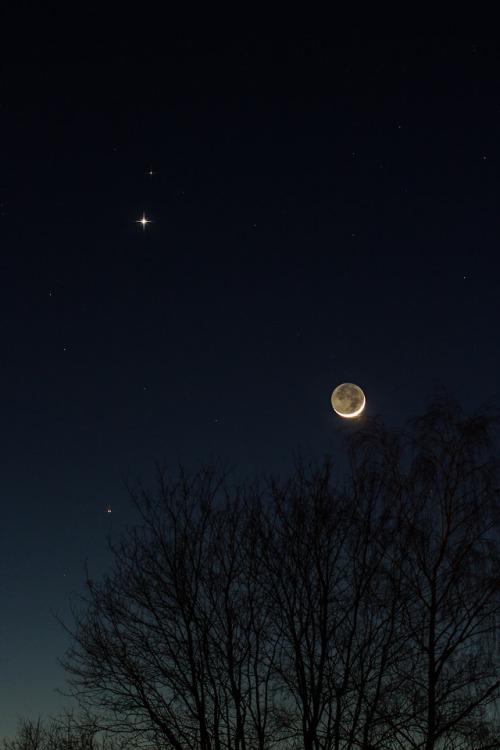
Conjunction: Mars, Venus and Moon
by Stefan Grießinger

Conjunction: Mars, Venus and Moon
by Stefan Grießinger
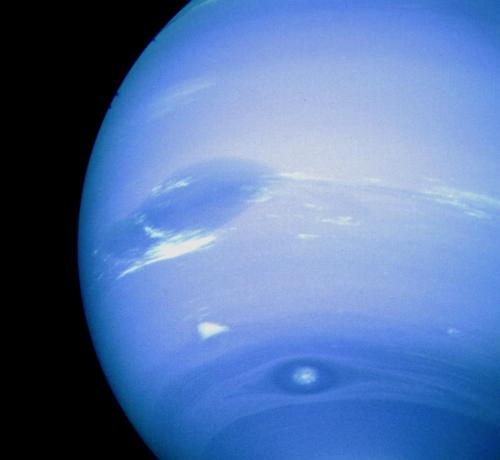
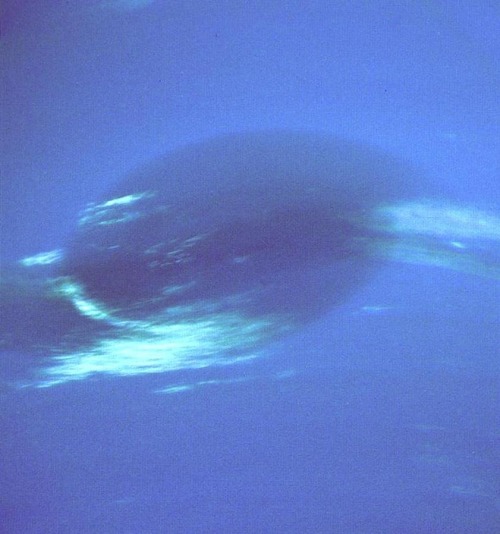
This photograph of Neptune was reconstructed from two images taken by Voyager 2’s narrow-angle camera, through the green and clear filters. At the north (top) is the Great Dark Spot, accompanied by bright, white clouds that undergo rapid changes in appearance.
Credit: NASA

Conjunction: Mars, Venus and Moon
by Stefan Grießinger

Conjunção entre os planetas Marte e Saturno nessa madrugada do dia 2 de Abril de 2018!  #PlanetaMarte #PlanetaSaturno #Stellarium
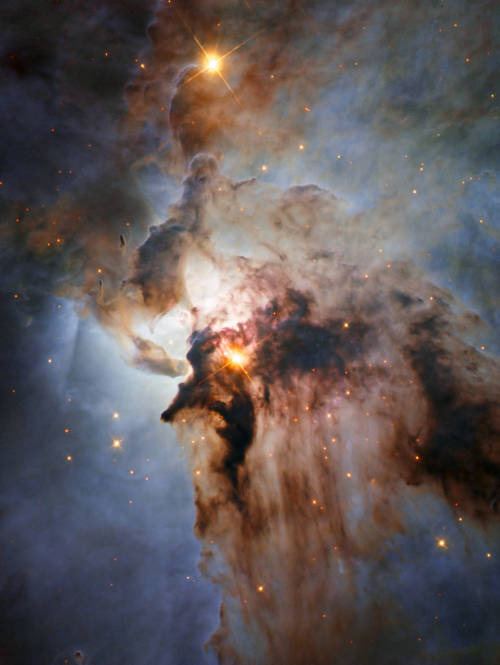
This new NASA/ESA Hubble Space Telescope image shows the center of the Lagoon Nebula, an object with a deceptively tranquil name, in the constellation of Sagittarius. The region is filled with intense winds from hot stars, churning funnels of gas, and energetic star formation, all embedded within an intricate haze of gas and pitch-dark dust.
Image Credit: NASA/JPL/ESA/J. Trauger
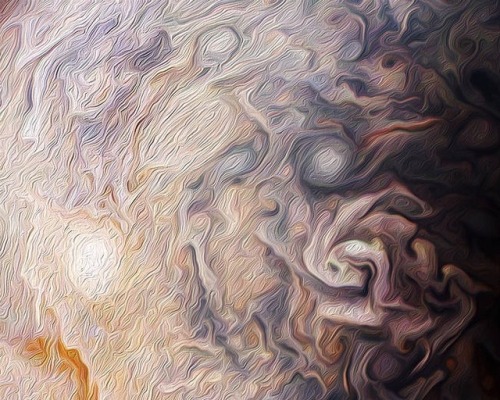

Citizen scientist Rick Lundh created this abstract Jovian artwork using data from the JunoCam imager on NASA’s Juno spacecraft.
Image credits: NASA/JPL-Caltech/SwRI/MSSS/Rick Lundh
What is Gravitational Lensing?
A gravitational lens is a distribution of matter (such as a cluster of galaxies) between a distant light source and an observer, that is capable of bending the light from the source as the light travels towards the observer. This effect is known as gravitational lensing, and the amount of bending is one of the predictions of Albert Einstein’s general theory of relativity.

This illustration shows how gravitational lensing works. The gravity of a large galaxy cluster is so strong, it bends, brightens and distorts the light of distant galaxies behind it. The scale has been greatly exaggerated; in reality, the distant galaxy is much further away and much smaller. Credit: NASA, ESA, L. Calcada
There are three classes of gravitational lensing:
1° Strong lensing: where there are easily visible distortions such as the formation of Einstein rings, arcs, and multiple images.

Einstein ring. credit: NASA/ESA&Hubble
2° Weak lensing: where the distortions of background sources are much smaller and can only be detected by analyzing large numbers of sources in a statistical way to find coherent distortions of only a few percent. The lensing shows up statistically as a preferred stretching of the background objects perpendicular to the direction to the centre of the lens. By measuring the shapes and orientations of large numbers of distant galaxies, their orientations can be averaged to measure the shear of the lensing field in any region. This, in turn, can be used to reconstruct the mass distribution in the area: in particular, the background distribution of dark matter can be reconstructed. Since galaxies are intrinsically elliptical and the weak gravitational lensing signal is small, a very large number of galaxies must be used in these surveys.

The effects of foreground galaxy cluster mass on background galaxy shapes. The upper left panel shows (projected onto the plane of the sky) the shapes of cluster members (in yellow) and background galaxies (in white), ignoring the effects of weak lensing. The lower right panel shows this same scenario, but includes the effects of lensing. The middle panel shows a 3-d representation of the positions of cluster and source galaxies, relative to the observer. Note that the background galaxies appear stretched tangentially around the cluster.
3° Microlensing: where no distortion in shape can be seen but the amount of light received from a background object changes in time. The lensing object may be stars in the Milky Way in one typical case, with the background source being stars in a remote galaxy, or, in another case, an even more distant quasar. The effect is small, such that (in the case of strong lensing) even a galaxy with a mass more than 100 billion times that of the Sun will produce multiple images separated by only a few arcseconds. Galaxy clusters can produce separations of several arcminutes. In both cases the galaxies and sources are quite distant, many hundreds of megaparsecs away from our Galaxy.
Gravitational lenses act equally on all kinds of electromagnetic radiation, not just visible light. Weak lensing effects are being studied for the cosmic microwave background as well as galaxy surveys. Strong lenses have been observed in radio and x-ray regimes as well. If a strong lens produces multiple images, there will be a relative time delay between two paths: that is, in one image the lensed object will be observed before the other image.

As an exoplanet passes in front of a more distant star, its gravity causes the trajectory of the starlight to bend, and in some cases results in a brief brightening of the background star as seen by a telescope. The artistic concept illustrates this effect. This phenomenon of gravitational microlensing enables scientists to search for exoplanets that are too distant and dark to detect any other way.Credits: NASA Ames/JPL-Caltech/T. Pyle
Explanation in terms of space–time curvature

Simulated gravitational lensing by black hole by: Earther
In general relativity, light follows the curvature of spacetime, hence when light passes around a massive object, it is bent. This means that the light from an object on the other side will be bent towards an observer’s eye, just like an ordinary lens. In General Relativity the speed of light depends on the gravitational potential (aka the metric) and this bending can be viewed as a consequence of the light traveling along a gradient in light speed. Light rays are the boundary between the future, the spacelike, and the past regions. The gravitational attraction can be viewed as the motion of undisturbed objects in a background curved geometry or alternatively as the response of objects to a force in a flat geometry.

A galaxy perfectly aligned with a supernova (supernova PS1-10afx) acts as a cosmic magnifying glass, making it appear 100 billion times more dazzling than our Sun. Image credit: Anupreeta More/Kavli IPMU.
To learn more, click here.

Have a nice Pi-Day! In memory of Stephen Hawking!
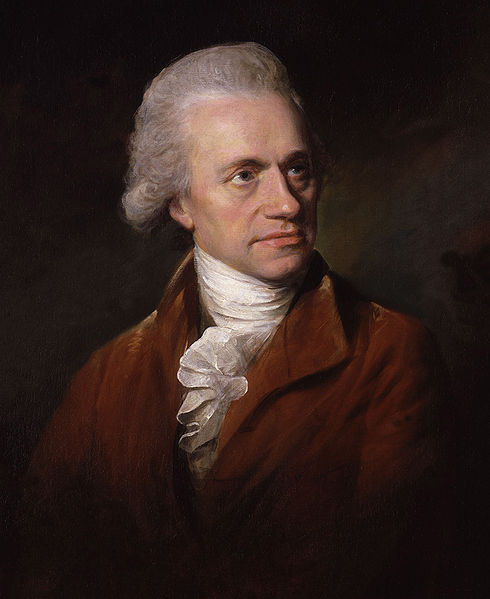
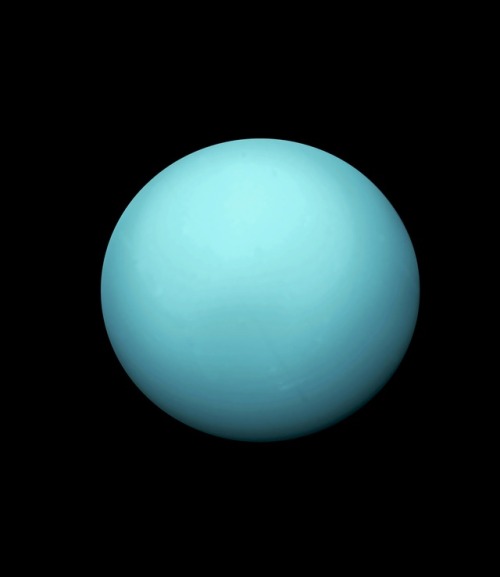
William Herschel
Frederick William Herschel, was a British astronomer and composer of German origin, and brother of fellow astronomer Caroline Herschel, with whom he worked. Born in the Electorate of Hanover, Herschel followed his father into the Military Band of Hanover, before migrating to Great Britain in 1757 at the age of nineteen.
Herschel constructed his first large telescope in 1774, after which he spent nine years carrying out sky surveys to investigate double stars. The resolving power of the Herschel telescopes revealed that the nebulae in the Messier catalogue were clusters of stars. Herschel published catalogues of nebulae in 1802 (2,500 objects) and in 1820 (5,000 objects). In the course of an observation on 13 March 1781, he realized that one celestial body he had observed was not a star, but a planet, Uranus.

This was the first planet to be discovered since antiquity and Herschel became famous overnight. As a result of this discovery, George III appointed him Court Astronomer. He was elected as a Fellow of the Royal Society and grants were provided for the construction of new telescopes.
Herschel pioneered the use of astronomical spectrophotometry as a diagnostic tool, using prisms and temperature measuring equipment to measure the wavelength distribution of stellar spectra. Other work included an improved determination of the rotation period of Mars, the discovery that the Martian polar caps vary seasonally, the discovery of Titania and Oberon (moons of Uranus) and Enceladus and Mimas (moons of Saturn). In addition, Herschel discovered infrared radiation. Herschel was made a Knight of the Royal Guelphic Order in 1816. He was the first President of the Royal Astronomical Society when it was founded in 1820. He died in August 1822, and his work was continued by his only son, John Herschel.
Animation taken from the video ‘‘The Discovery of Uranus’’
To know more about the history of William Herschel, click here.

